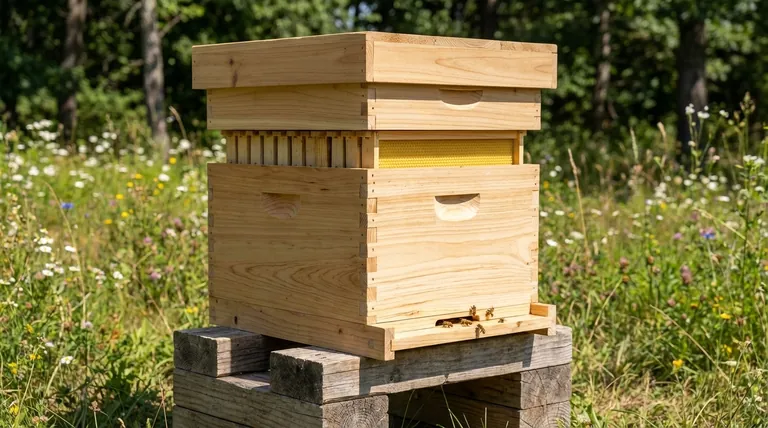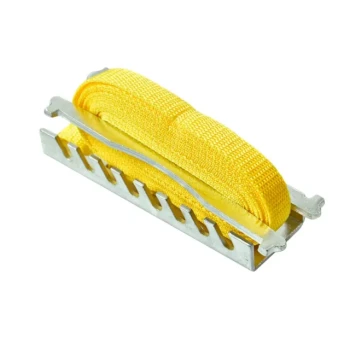At its core, a basic beehive is a modular, vertically stacked structure providing shelter and organized space for a honeybee colony. The standard starter setup consists of a bottom board for the floor and entrance, a deep hive body (or "brood box") containing frames and foundation where the queen lays eggs, an inner cover for ventilation, and a telescoping outer cover for weather protection.
A beehive is not a static object but a dynamic system designed to expand with the colony. Your initial setup provides the essential nursery and living quarters; you will add more components as the bee population grows and begins to store surplus honey.

The Anatomy of a Beehive: Component by Component
Understanding the function of each part is key to managing your hive effectively. The components work together to create a safe, productive environment for the bees.
The Foundation: Hive Stand and Bottom Board
The entire hive rests on a hive stand, which can be as simple as cinder blocks or a purpose-built wooden base. Its job is to elevate the hive off the damp ground, improve air circulation, and deter pests.
The bottom board serves as the floor of the hive and provides the main entrance for the bees. You will encounter two primary types: solid and screened, each with its own advantages.
The Nursery: The Deep Hive Body (Brood Box)
This is the heart of the colony. The deep hive body, also called the brood chamber, is the large box that sits directly on the bottom board.
This box is where the queen bee lives and lays her eggs. It's where the worker bees raise the young (the brood) and store the initial pollen and honey needed to feed the colony. A starting hive has one brood box.
The Internal Structure: Frames and Foundation
Inside the hive body hang a series of frames, typically 8 or 10 depending on the hive's width. These wooden or plastic rectangles provide the structure upon which the bees build their wax comb.
Most frames are fitted with foundation, a thin sheet of beeswax or plastic embossed with the hexagonal pattern of honeycomb. This foundation encourages the bees to build straight, orderly combs, making the hive much easier to inspect and manage.
The Ceiling: Inner and Outer Covers
The inner cover is a simple board that sits directly on top of the uppermost hive box. It provides a layer of dead air space for insulation and often has a notch to create a small upper entrance for ventilation.
Finally, the outer cover (or telescoping cover) acts as the roof. It fits over the inner cover and the top of the hive body, protecting the colony from rain, sun, and other elements.
From Basic Setup to a Thriving Colony
A new beekeeper starts with the basic setup, but as the colony grows, you must add more space. This expansion is almost always done vertically.
Adding Honey Supers
When the bees have filled most of the brood box with comb, brood, and resources, you will add another box on top. These boxes, called "supers," are intended for honey storage.
Supers are often shallower ("medium" or "shallow" depth) than the deep brood box, making them lighter and easier to lift when full of heavy honey.
The Optional Gatekeeper: The Queen Excluder
A queen excluder is a flat grid of wire or plastic that can be placed between the brood box and the honey supers. The slots are large enough for worker bees to pass through but too small for the larger queen.
Using an excluder ensures that the honey supers contain only honey, with no eggs or developing brood, which simplifies the harvesting process.
Understanding the Trade-offs
When purchasing your first hive, you will face a few key decisions. There is no single "best" answer; the right choice depends on your physical ability, climate, and beekeeping philosophy.
Hive Size: 8-Frame vs. 10-Frame
A 10-frame hive is the traditional standard, offering more space for brood and honey. A fully-loaded deep box can, however, weigh over 80 pounds.
An 8-frame hive uses the same depth but is narrower. The boxes are significantly lighter and easier to handle, making it a popular choice for beekeepers with back concerns, though it may require adding supers sooner.
Bottom Boards: Solid vs. Screened
A solid bottom board is traditional and offers better insulation, which can be an advantage in colder climates.
A screened bottom board replaces most of the wood floor with a wire screen. This dramatically increases ventilation, reduces moisture buildup, and is a key tool for monitoring and managing varroa mite populations.
Making the Right Choice for Your Goal
Your initial equipment choices set the stage for your first season. Focus on your primary objective to simplify your decision.
- If your primary focus is ease of handling: Choose an 8-frame hive configuration to keep the components lighter and more manageable.
- If your primary focus is maximizing potential honey yield: A 10-frame hive offers more space per box and is the traditional commercial standard.
- If your primary focus is pest management and ventilation: A screened bottom board is an invaluable tool and is highly recommended for most new beekeepers.
Your first beehive is the starting point of a fascinating journey into the world of honeybees.
Summary Table:
| Component | Function | Key Consideration |
|---|---|---|
| Hive Stand & Bottom Board | Elevates hive, provides entrance | Solid (insulation) vs. Screened (ventilation/pest control) |
| Deep Hive Body (Brood Box) | Nursery for brood & initial food storage | Core living space for the queen and colony |
| Frames & Foundation | Structure for bees to build wax comb | Encourages straight, manageable combs |
| Inner & Outer Covers | Provides ventilation and weather protection | Creates a stable internal environment |
| Honey Supers (Added Later) | Boxes for surplus honey storage | Added as the colony expands |
Ready to build your productive apiary with professional-grade equipment?
At HONESTBEE, we supply commercial apiaries and beekeeping equipment distributors with durable, reliable beehive components through our wholesale-focused operations. Whether you're starting a new operation or scaling an existing one, our equipment is designed for maximum colony health and beekeeper efficiency.
Contact our team today to discuss your wholesale needs and get a quote tailored to your operation.
Visual Guide

Related Products
- Langstroth Honey Bee Box Hive Boxes for Different Depths
- Professional Galvanized Hive Strap with Secure Locking Buckle for Beekeeping
- 5 Frame Wooden Nuc Box for Beekeeping
- Heavy-Duty Nylon Beehive Hive Strap with Stainless Steel Cinch Buckle
- HONESTBEE Durable Frame Wiring Board with Integrated Tensioner
People Also Ask
- How should hive boxes be aligned after reassembly? Ensure a Perfect Seal for Hive Health
- How is checking honey supers in a Langstroth hive different from inspecting Honey Flow supers? A Guide to Disruptive vs. Non-Invasive Methods
- How does a hive box work? A Guide to the Langstroth Hive System for Beekeepers
- How deep is a medium bee box? Unlock the Key to a Versatile and Manageable Hive
- What are the sizes of supers available in a standard hive? A Guide to Deep, Medium, and Shallow Boxes



















